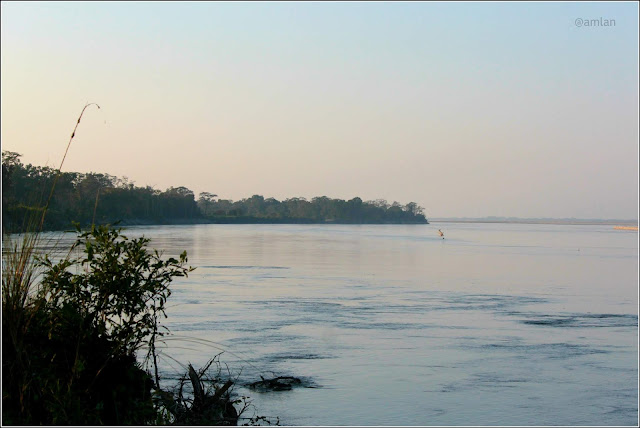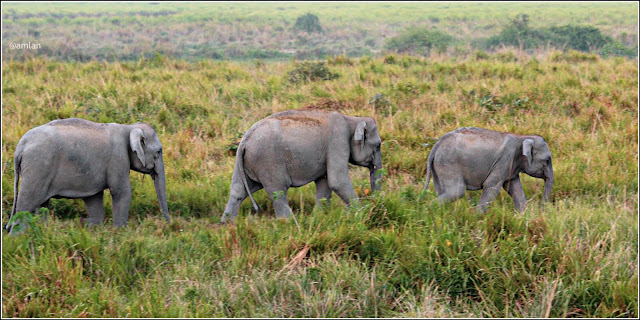KAZIRANGA ……... THE SYNERGY AND SYMBIOSIS OF LIFE WITH NATURE…..
Once you land in Gauhati your journey to the exotic begins.
Gauhati is very well connected from any corner of India by flights or train.
You may wish to spend that day in Gauhati. There are plenty of places where one
can stay. There is a decent and clean place for everyone and every pocket. In
the evening while being in Gauhati one must also do the great Brahmaputra
cruise. ( My next blog will be about the same.). We came into Gauhati a little after 2PM.
Next day early morning we started our journey to the
Kaziranga ranges. The Kaziranga ranges are in the north of Gauhati and the
journey by road takes approximately 5 hours. One can also take the train from
Gauhati and the nearest railway station to Kaziranga are Furkating on the east,
which is 80 km away. Furkating is connected by trains from Guwahati. A metre
gauge railway track earlier laid by Assam Bengal Railway from
Chittagong to Lumding was extended to Tinsukia on the Dibru-Sadiya line in 1903.
Point to note is that this railway line from Gauhati to Furkating is one of the oldest railway lines in India
and is still functional. .
One very important traffic rule in Assam is that no vehicles
are allowed to carry overhead luggage. Therefore we had a tote bag and a handbag plus our camera equipment backpack. The journey to Kaziranga itself is one
of the most scenic road journeys I have undertaken apart from the Himalayan
mountain roads and the north Bengal roads.
Kaziranga has three ranges. The western range is the Bagori
range, the centre is the Kohora range, and the eastern s the Aagoritoli range.
Kaziranga National Park – a world
heritage site, the park hosts two-thirds of the world’s Great One-horned
rhinoceros. Kaziranga also boasts the highest density of tigers among the
protected areas in the world and was declared a Tiger Reserve in 2006. Though
sighting of tigers is difficult because of the tall grasses that provide
excellent camouflage, their presence can be felt everywhere by way of pug
marks, kills and territorial markings. The park is home to large breeding
populations of elephants, wild water buffalo and swamp deer.
 |
| WILD WATER BUFFALO.....THESE ARE VERY POWERFUL AND DANGEROUS ANIMALS |
The history of protection in
Kaziranga dates back to the early twentieth century when Baroness Mary
Victoria Leiter Curzon, an American who was the wife of Lord Curzon,
the Viceroy of India first visited the Kaziranga area in 1904. Kaziranga
had been renowned for its rhinoceros population, however, during her
trips in the region, Baroness Curzon failed to see any rhinoceros, seeing only
some hoof marks.
It is rumoured that the noted Assamese
animal tracker, Balaram Hazarika,
showed Baroness Curzon around Kaziranga and impressed upon her the urgent need
for the conservation of the wildlife. Concerned
about the dwindling numbers of rhinoceros, she asked her husband to take the
necessary action to save the rhinoceros, which he did on 4 November 1904 when
he proposed the creation of a reserve in Kaziranga.
Thus
the Kaziranga Proposed Reserve Forest was created on 57,273.6 acres (232 km²)
of land, on 1 June 1905 by notification of the Chief Commissioner of
the area.
Having given you all some idea about Kaziranga and its ranges
lets now delve into the visuals of this pristine, divine, and mesmerizing place.
We started our Kaziranga tour with the visit to the AGORITOLI
RANGE. This is the easternmost range and the largest of the three ranges. It
is characterized by the topography which is grassland and marshy water land.
River Brahmaputra flows on the northern side of the range and is very wide and
placid in character.
In my knowledge, till I visited Kaziranga I never knew that
Kaziranga has three ranges but the AGORITOLI RANGE was the first of the three
ranges developed and it created an impression of heaven on earth. It was our
first day in the forest ranges. After checking into our Eco resort at Kohora we
had taken the afternoon Safari to Agoritoli which was around 1400 hrs. We
reached Agoritoli at around 1445 hrs and taking the necessary permissions we
entered the forest
The first thing that I noticed is the abundance of the wild
water buffalos and the Asiatic one horn Rhinoceros. It was like domestic cows
grazing everywhere. I was amazed by the conservation effort that brought about
this humongous change. These one horned Rhinos have poached near to extinction
about three decades ago but the efforts of the government and the wildlife
enthusiast brought about a change that was visible. It was approaching the golden
hour for photography but we were more mesmerized by the beauty of the forest.
We just wanted to be THERE. I did click some photographs with my cell phone and
later with my DSLR. Something in me told me that we will get many more
opportunity to click many a beautiful shot.
The next day we went to KOHORA range and that’s when I realized
that the Asiatic one horn rhino, The wild water buffalos, the elephants, the
hog dear all proliferates with abundance. Nature and human interaction have
brought about a splendid harmony where humans benefits with the wildlife and
environment conservation and so does the wild animals. It is indeed a success
story.
 |
| BRAHMAPUTRA ON THE NORTHERN EDGE OF THE RANGES |
 |
| THE GOLDEN HOUR SHOT OF THE RANGE |
 |
| DUSK APPROACHING |
KAZIRANGA is a place, a forest range where one gets as close as possible to raw, live,
vibrant and mesmerizing nature
The forest and the environment therein was a spiritual
experience and I urge all to visit Kaziranga once in their lifetime to
experience THE SYNERGY AND SYMBIOSIS OF LIFE WITH NATURE.













Comments
Post a Comment